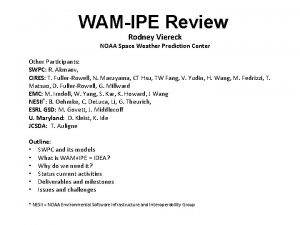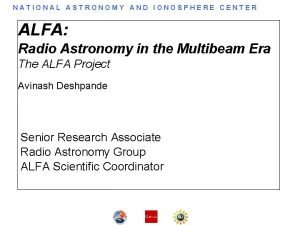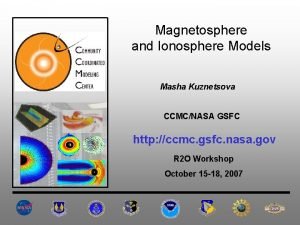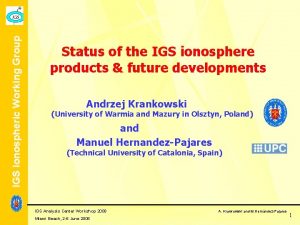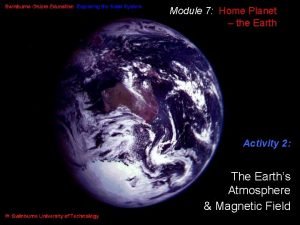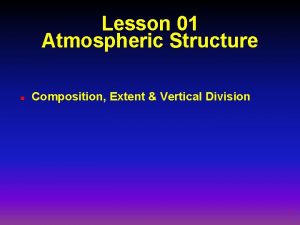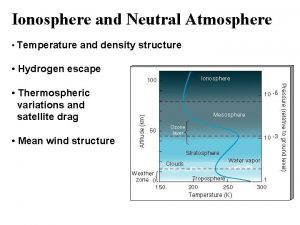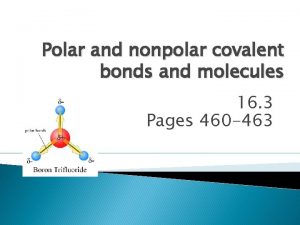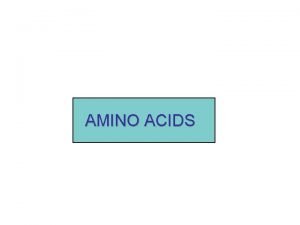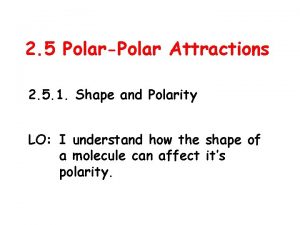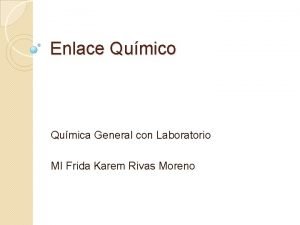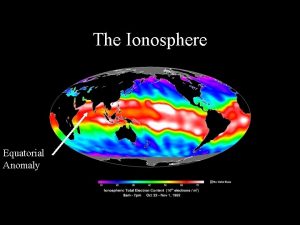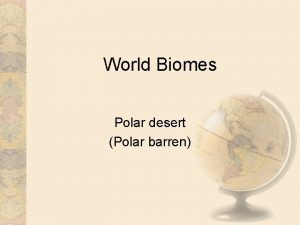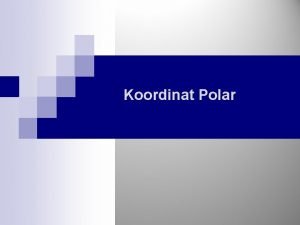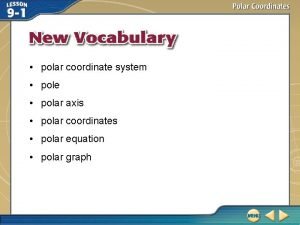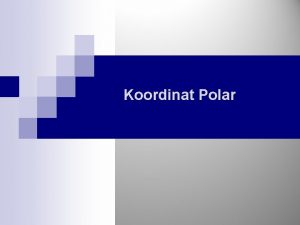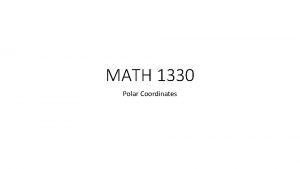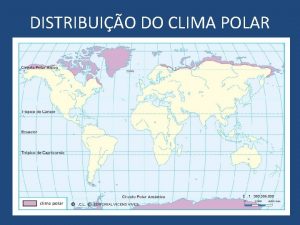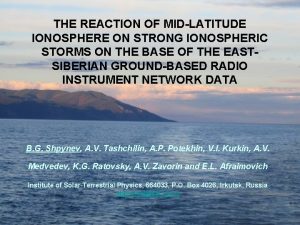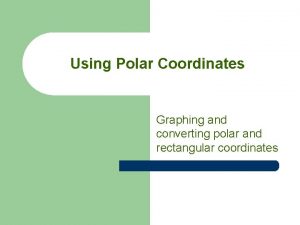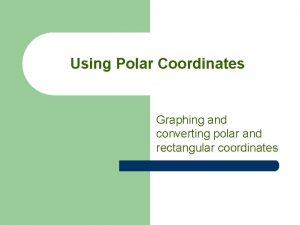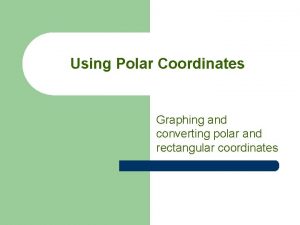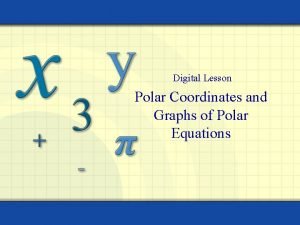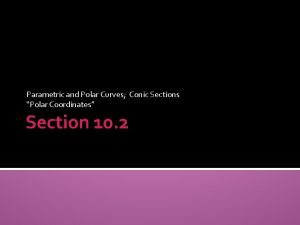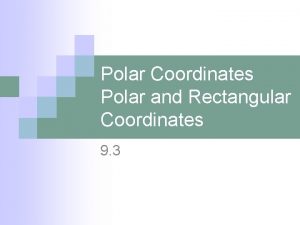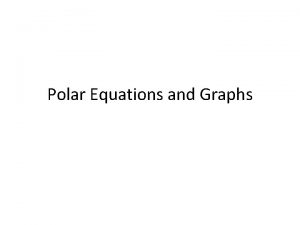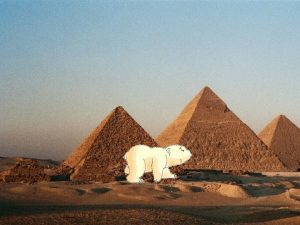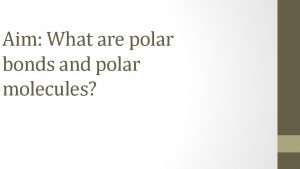Peculiarities of the ionospheric Polar ionosphere and Ionospheric































- Slides: 31

Peculiarities of the ionospheric Polar ionosphere and Ionospheric Effects of Geomagnetic Storms in Different Longitude Sectors response to geomagnetic storms in the ionospheric disturbances East-Asian region Variations of ionospheric parameters in the by G. A. Zherebtsov, O. M. Pirog, and A. S. Potapov - all ISTP SB RAS, quiet and weak disturbed condition Irkutsk, Russia

Polar ionosphere and ionospheric disturbances • This presentation combines two proposals: • (ID No: 947) Research into physical processes of the polar and subpolar ionosphere and the action of high-latitude disturbances on the midlatitude ionosphere using space-borne and ground-based measurements. (Polar Ionosphere) • (ID No: 1078) Dynamics of high-latitude ionosphere disturbances and their influence on the ionosphere of middle and low latitudes (Ionosphere Disturbances)

ID No: 947 The Leader: Prof Geliy Zherebtsov Scientific Council of RAS on Solar-Terrestrial Physics, dir@idg. chph. ras. ru • Other project members and their affiliation • Solovyev S. I. Institute of Cosmophysical Research and Aeronomy SB RAS (ICRA), Yakutsk; s. i. solovyev@ikfia. ysn. ru • Tereschenko E. D Polar Geophysical Institute (PGI); edteres@pgi. ru • Zelenyi L. M. Institute of Space Research (ISR); lzelenyi@iki. rssi. ru • Kurkin V. I. Institute of Solar-Terrestrial Physics of Siberian Branch (SB) of RAS (ISTP); kurkin@iszf. irk. ru • Romanova E. B. Institute of Solar-Terrestrial Physics of Siberian Branch (SB) of RAS (ISTP); ebr@iszf. irk. ru • Shevtsov B. M. Institute of Cosmophysical Research and Radio Wave Propagation of Far East Branch of RAS (ICRR), bshev@ikir. kamchatka. ru

ID No: 1078 The Leader: Prof Geliy Zherebtsov Scientific Council of RAS on Solar-Terrestrial Physics, dir@idg. chph. ras. ru Other project members and their affiliation • Afraimovich E. L. Institute of Solar-Terrestrial Physics of Siberian Branch (SB) of RAS (ISTP); afra@iszf. irk. ru • Pirog O. M. Institute of Solar-Terrestrial Physics of Siberian Branch (SB) of RAS (ISTP); pir@iszf. irk. ru • Smirnov V. F. Institute of Cosmophysical Research and Aeronomy SB RAS (ICRA); v_f_smirnov@ikfia. ysn. ru • Jiankui Shi Center for Space Science and Applied Research of Chinese Academy of Sciences (CSSAR CAS) jkshi@cssar. ac. cn. • Xiao Wang Center for Space Science and Applied Research of Chinese Academy of Sciences (CSSAR CAS) wangx@center. cssar. ac. cn.

Contents • Introduction • Main scientific problems for the ionosphere studies • Observations of the ionosphere in Eastern Siberia • The Meridian Project Framework • Response of ionosphere to the geomagnetic disturbances • Conclusions

Introduction • The high-latitude ionosphere is a complex system, and its principal peculiarity is the fact that besides the sun illumination there is another source of ionization taking place at these latitudes - the precipitation of particle fluxes. Therefore ionosphere at high latitudes substantially depends on various phenomena in the Earth’s magnetosphere. • According to the ground-based and satellite observations of the ionosphere response to the magnetosphere disturbances has a clearly expressed longitudinal dependence. The nature of this dependence is determined by the disagreement between geographic coordinate system to which distribution of the neutral atmosphere parameters and solar radiation are related and geomagnetic system, where the distribution of magnetosphere sources is regulated.

Introduction • In Russia polar and near-polar regions occupy great territories of ten time zones. • In the Eastern-Asian longitudinal sector the largest discrepancy of geographic coordinates relative to geomagnetic ones takes place, and formation of a large-scale structure (main ionospheric trough, zone of auroral ionization) proceeds at the background of lowest over the Earth values of electron density. The given project is directed to the study of the influence mechanism of this discrepancy on the development process of ionosphere storm along the Eastern. Asian meridian from auroral to equatorial latitudes. The effective solution of this problem is possible as a result of joint ionosphere observations made by Russian and Chinese scientists.

Main scientific problems for the ionosphere studies: • Response of the polar, auroral, subauroral, and midlatitude ionosphere in the Siberian longitudinal sector to the disturbances coming from the Sun, interplanetary medium, and the Earth’s magnetosphere • Dynamics of the large-scale structures of the highlatitude ionosphere • Penetration of the ionospheric electric fields from auroral regions into the mid-latitude ionosphere • The propagation of ionospheric disturbances • Radio wave propagation in the ionosphere

Ground based facilities Magnetic and ionospheric observations ionosphere sounding observations of the atmospheric emissions magnetic observations

Observations of the ionosphere in Eastern Siberia Disposition of facilities for the ionosphere observations in East Siberia and Far East is illustrated. Blue lines show radio paths with transmitters situated in Norilsk, Magadan and Khabarovsk, and receiver located in Irkutsk.

Observations of the ionosphere in Eastern Siberia The Irkutsk incoherent scatter (IS) radar (53 N, 103. 3 E) measures electron densities, electron and ion temperatures, and plasma drift velocities

Observations of the ionosphere in Eastern Siberia Basic parameters of Irkutsk ISR Range of frequencies Peak output power Pulse duration Type of antenna (154 -162) MHz 3. 2 MW 70 -1040 mks Sector horn Antenna gain 35 -38 d. B Angular size of the beam 0. 5° x 10° Scan sector Polarization ± 30° Linear

Observations of the ionosphere in Eastern Siberia Example of the IS radar measurements during a magnetic storm

Observations of the ionosphere in Eastern Siberia Irkutsk (52°N, 104°E) Ionospheric Station on the base of Digisonde Portable System DPS-4

Observations of the ionosphere in Eastern Siberia Chirp Sounder Transmitter

Observations of the ionosphere in Eastern Siberia Chirp-ionosonde system. Main characteristics Sounding frequency range, MHz 1. 0 – 35. 0 Frequency-sweep rate, k. Hz/s 10 – 10000 Frequency resolution, k. Hz VIS OIS, BS 20 40 Delay resolution, km 1. 5 Distance of sounding, km Methods of sounding 90 - 40000 Vertical Incidence Oblique Incidence Backscatter

Observations of the ionosphere in Eastern Siberia V S Vertical sounding Oblique sounding Backscatter The system allows measurements to be made of the ionospheric parameters over extensive Russia region from subpolar to middle latitudes within the longitudinal sector 90°― 150° E.

Observations of the ionosphere in Eastern Siberia GPS measurements of the travelling ionospheric disturbances (TID) propagation Locations of GPS receivers are noted by red dots. Lilac lines show the spatial positions of the TEC maxima for four successive moments of time. Arrows show directions of propagation of this disturbance. The length of the arrows represents approximately the values of velocities which change from 70 to 335 m/s.

Observations of the ionosphere in Eastern Siberia Comparison of the ionospheric disturbance according to the TEC and fo. F 2 data: (a) and (b) on November 8, 2004; (c) on November 10, 2004. Blue curves show the filtered TEC variations d. I(t). The lines with triangles the critical frequency variations. The changes in the critical frequency fo. F 2 correspond to a relative amplitude of electron density disturbance d. N/N of about 80% in the region of the F 2 layer maximum.

Observations of the ionosphere in Eastern Siberia Statistical pattern of ionospheric disturbances on the polar wall of MIT at the different latitudes for the minimum and maximum solar activity Location of the polar wall of the main ionospheric trough in the coordinates: invariant latitude – local time for the different Kp. Φ = 150. 6 – 5 t – 25√ (0. 1 Kp 2 – 1. 3 t + 12. 7)

The Meridian Project Framework The International Space Weather Meridian Circle Program (ISWMCP), proposal to connect 120ºE and 60ºW meridian chains of ground based monitors and enhance the ability of monitoring space environment worldwide.

The Meridian Project Framework Extension of MP into Russia

Response of ionosphere to the geomagnetic disturbances • In the framework of the joint Russian - Chinese project the morphological analysis of the development of ionospheric storms along the meridian from auroral zone to equator was conducted. There were used the data obtained from the network of stations of Easter-Siberian region and China located within the latitude-longitude sector (20 – 70 N, 90– 160 Е). • The numerical model for ionosphere-plasmasphere coupling developed at the ISTP SB RAS is used to interpret the data of observation.

Response of ionosphere to the geomagnetic disturbances n The variations of Dst-index and F 2 -layer critical frequencies during the storms observed in the different seasons at the different latitudes. The blue line is the quit diurnal variation, and the red line is the current values of fo. F 2.

Response of ionosphere to the geomagnetic disturbances The variations of fo. F 2 and fb. Es (stars) during the great storm with two main phases are presented. The more interesting data were obtained at midlatitude stations. In the afternoon hours of LT on November 8 a large-scale ionosphere disturbance is detected. The level of the night ionization considerably increases with decreasing latitude separating into some peaks.

Response of ionosphere to the geomagnetic disturbances The Irkutsk ionograms from 0700 to 1030 UT, illustrating the sudden increase and the following depletion of fo. F 2 during the advent of large-scale ionosphere disturbance.

Response of ionosphere to the geomagnetic disturbances Variations of fo. F 2 in the LT – geomagnetic latitude coordinate system in the quiet day on November 5, 2004 (on the left) and disturbed day on November 8 (on the right). The maximum is fixed in LT.

Response of ionosphere to the geomagnetic disturbances The results of simulation of the ionospheric behavior during the storms (solid lines). Red circles – current values of the Nm. F 2 computed from fo. F 2; dotted lines – quiet level.

Response of ionosphere to the geomagnetic disturbances Calculated electron density distribution in the plane of magnetic meridian 120°E in a system of coordinates altitude – geomagnetic latitude is presented. We see the daytime ionization crusts at 05 UT and nighttime increasing of Ne above equator at 16 UT. These phenomena are typical for the equatorial ionosphere. So this model reproduces variation of electron density in the equatorial ionosphere well enough.

Conclusions • Building of physical model of ionospheric processes in polar regions can be a significant contribution to the IPY themes. • Meridian Project is a ground-based network which consists of a chain of ground-based observatories with multiple facilities. • The great contribution of the 120°E Meridian Project will be the investigation of ionospheric phenomena on the basis of the long-time coordinated observations in Russia and China from subauroral to equatorial latitudes and the analysis of collected experimental database. • International collaboration will make it possible to constitute the first complete environment monitoring chain around the globe.

Thank you
 Phonostylistics as a branch of phonetics
Phonostylistics as a branch of phonetics Wam-ipe
Wam-ipe Ionosphere
Ionosphere Astronomy
Astronomy Jdiss
Jdiss Ionosphere
Ionosphere Ionosphere
Ionosphere Stratosphere height
Stratosphere height Ionosphere
Ionosphere Ionosphere
Ionosphere Polar and nonpolar covalent bonds
Polar and nonpolar covalent bonds Amino acid r groups
Amino acid r groups Polar and non polar dielectrics
Polar and non polar dielectrics Uniones metalicas ejemplos
Uniones metalicas ejemplos Polar attractions are
Polar attractions are Enlace dativo
Enlace dativo Hình ảnh bộ gõ cơ thể búng tay
Hình ảnh bộ gõ cơ thể búng tay Lp html
Lp html Bổ thể
Bổ thể Tỉ lệ cơ thể trẻ em
Tỉ lệ cơ thể trẻ em Chó sói
Chó sói Tư thế worms-breton
Tư thế worms-breton Chúa yêu trần thế alleluia
Chúa yêu trần thế alleluia Môn thể thao bắt đầu bằng từ đua
Môn thể thao bắt đầu bằng từ đua Thế nào là hệ số cao nhất
Thế nào là hệ số cao nhất Các châu lục và đại dương trên thế giới
Các châu lục và đại dương trên thế giới Công thức tính độ biến thiên đông lượng
Công thức tính độ biến thiên đông lượng Trời xanh đây là của chúng ta thể thơ
Trời xanh đây là của chúng ta thể thơ Mật thư anh em như thể tay chân
Mật thư anh em như thể tay chân 101012 bằng
101012 bằng độ dài liên kết
độ dài liên kết Các châu lục và đại dương trên thế giới
Các châu lục và đại dương trên thế giới

